ACU HLSC122 Evidence Based Nursing Research: Paleo Diet Analysis
VerifiedAdded on 2023/06/09
|8
|1553
|275
Report
AI Summary
This report presents an analysis of two research papers evaluating the effectiveness of the Paleo diet. The first paper examines the metabolic and physiological improvements in overweight participants following the Paleo diet, highlighting reductions in body weight, fat mass, and improvements in insulin sensitivity, blood pressure, and lipid profiles. The second paper discusses both the benefits and potential drawbacks of the Paleo diet, noting the risk of calcium deficiency and suggesting calcium supplementation. Both studies address PICO elements, indicating that the Paleo diet can be a beneficial intervention for overweight individuals, though calcium intake should be monitored. This assignment is available on Desklib, where students can find more solved assignments and past papers.
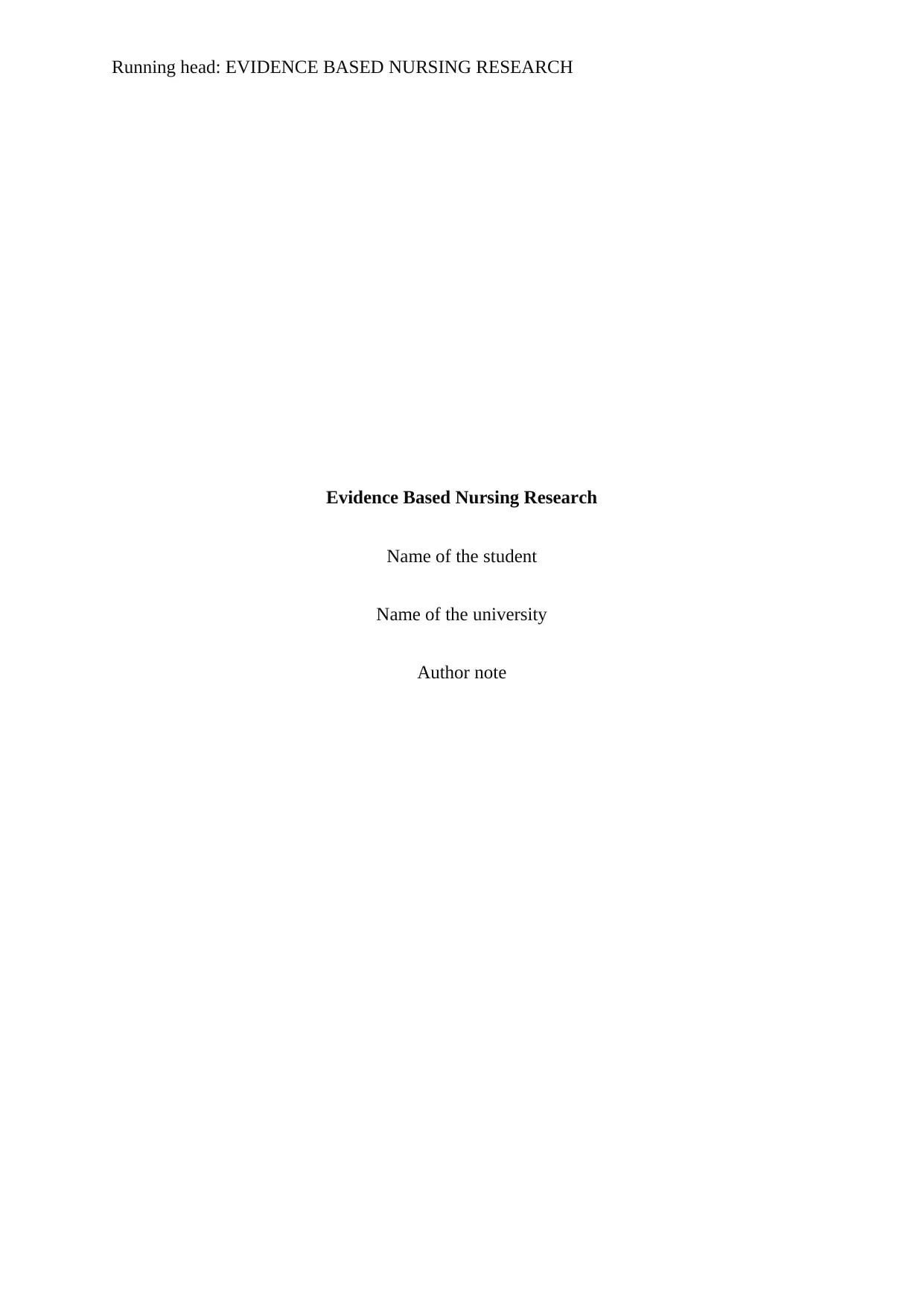
Running head: EVIDENCE BASED NURSING RESEARCH
Evidence Based Nursing Research
Name of the student
Name of the university
Author note
Evidence Based Nursing Research
Name of the student
Name of the university
Author note
Paraphrase This Document
Need a fresh take? Get an instant paraphrase of this document with our AI Paraphraser
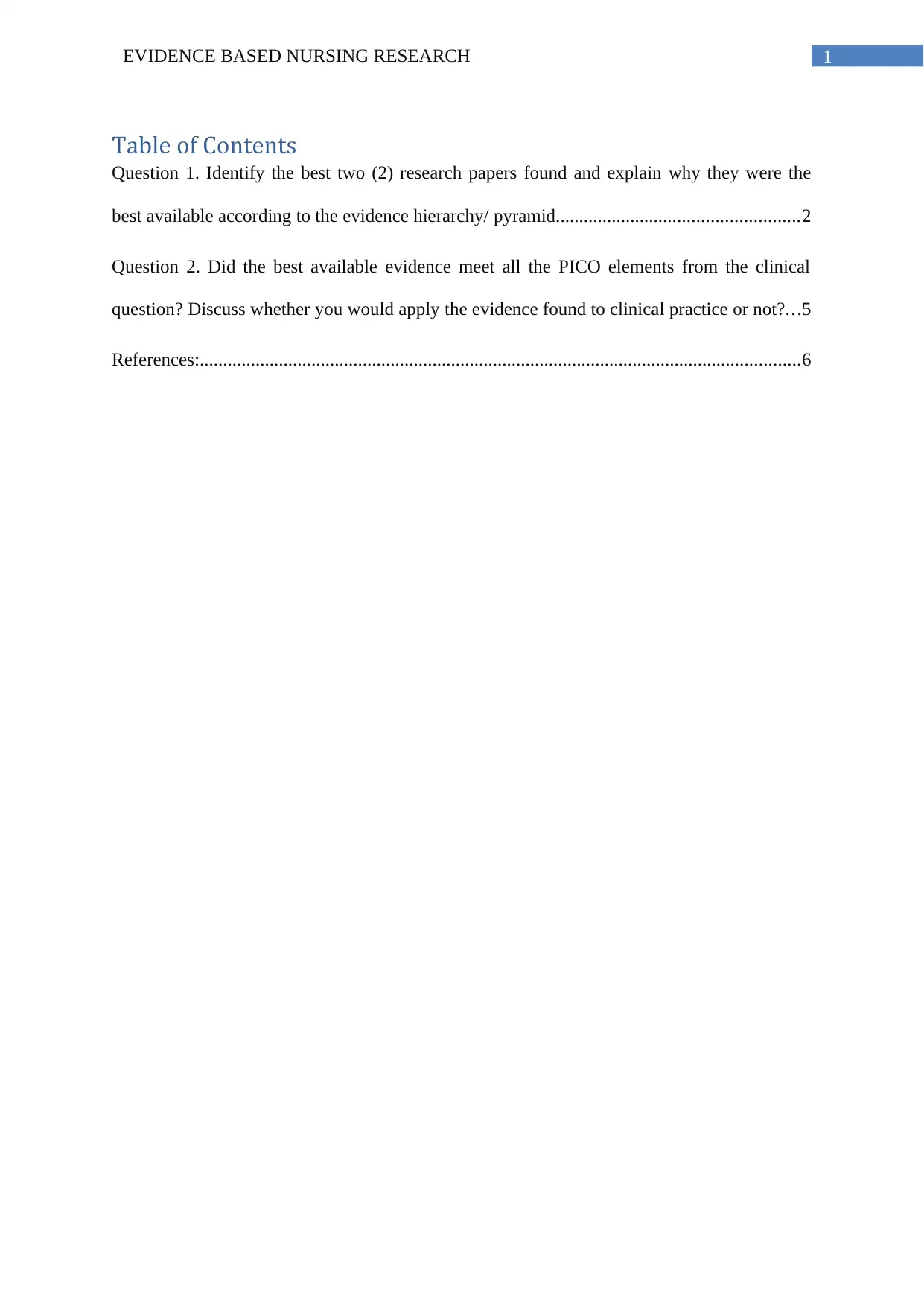
1EVIDENCE BASED NURSING RESEARCH
Table of Contents
Question 1. Identify the best two (2) research papers found and explain why they were the
best available according to the evidence hierarchy/ pyramid....................................................2
Question 2. Did the best available evidence meet all the PICO elements from the clinical
question? Discuss whether you would apply the evidence found to clinical practice or not?...5
References:.................................................................................................................................6
Table of Contents
Question 1. Identify the best two (2) research papers found and explain why they were the
best available according to the evidence hierarchy/ pyramid....................................................2
Question 2. Did the best available evidence meet all the PICO elements from the clinical
question? Discuss whether you would apply the evidence found to clinical practice or not?...5
References:.................................................................................................................................6
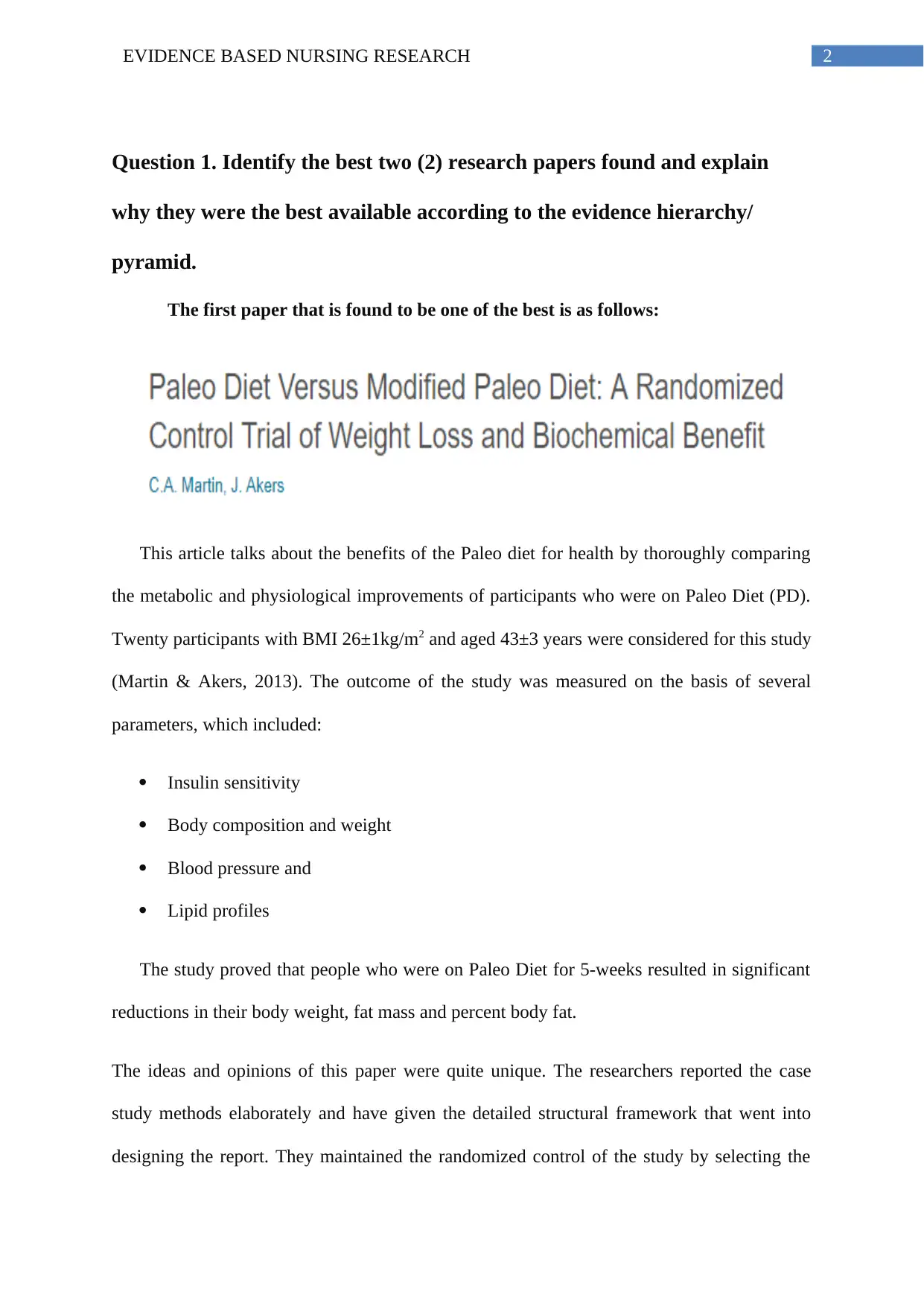
2EVIDENCE BASED NURSING RESEARCH
Question 1. Identify the best two (2) research papers found and explain
why they were the best available according to the evidence hierarchy/
pyramid.
The first paper that is found to be one of the best is as follows:
This article talks about the benefits of the Paleo diet for health by thoroughly comparing
the metabolic and physiological improvements of participants who were on Paleo Diet (PD).
Twenty participants with BMI 26±1kg/m2 and aged 43±3 years were considered for this study
(Martin & Akers, 2013). The outcome of the study was measured on the basis of several
parameters, which included:
Insulin sensitivity
Body composition and weight
Blood pressure and
Lipid profiles
The study proved that people who were on Paleo Diet for 5-weeks resulted in significant
reductions in their body weight, fat mass and percent body fat.
The ideas and opinions of this paper were quite unique. The researchers reported the case
study methods elaborately and have given the detailed structural framework that went into
designing the report. They maintained the randomized control of the study by selecting the
Question 1. Identify the best two (2) research papers found and explain
why they were the best available according to the evidence hierarchy/
pyramid.
The first paper that is found to be one of the best is as follows:
This article talks about the benefits of the Paleo diet for health by thoroughly comparing
the metabolic and physiological improvements of participants who were on Paleo Diet (PD).
Twenty participants with BMI 26±1kg/m2 and aged 43±3 years were considered for this study
(Martin & Akers, 2013). The outcome of the study was measured on the basis of several
parameters, which included:
Insulin sensitivity
Body composition and weight
Blood pressure and
Lipid profiles
The study proved that people who were on Paleo Diet for 5-weeks resulted in significant
reductions in their body weight, fat mass and percent body fat.
The ideas and opinions of this paper were quite unique. The researchers reported the case
study methods elaborately and have given the detailed structural framework that went into
designing the report. They maintained the randomized control of the study by selecting the
⊘ This is a preview!⊘
Do you want full access?
Subscribe today to unlock all pages.

Trusted by 1+ million students worldwide
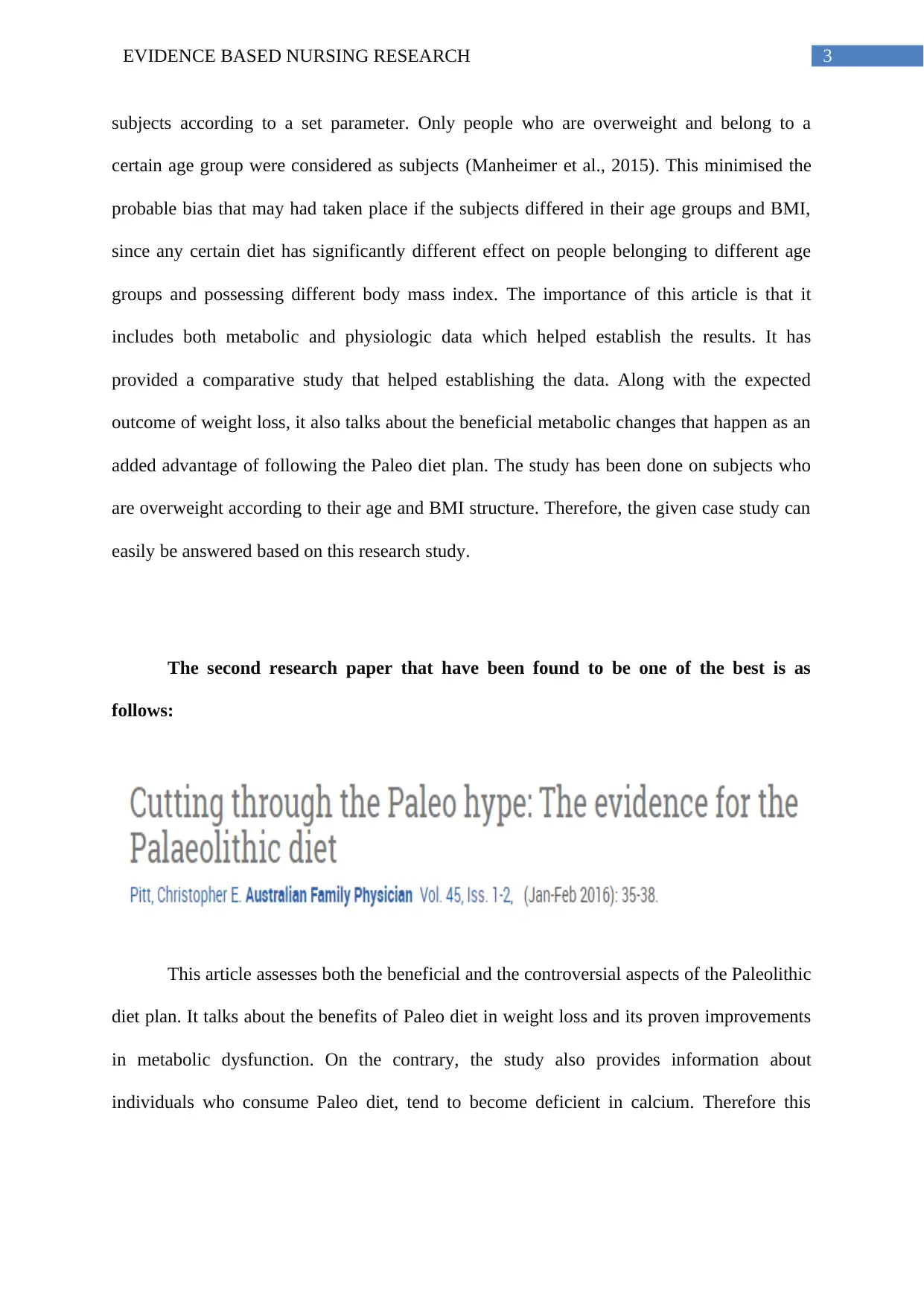
3EVIDENCE BASED NURSING RESEARCH
subjects according to a set parameter. Only people who are overweight and belong to a
certain age group were considered as subjects (Manheimer et al., 2015). This minimised the
probable bias that may had taken place if the subjects differed in their age groups and BMI,
since any certain diet has significantly different effect on people belonging to different age
groups and possessing different body mass index. The importance of this article is that it
includes both metabolic and physiologic data which helped establish the results. It has
provided a comparative study that helped establishing the data. Along with the expected
outcome of weight loss, it also talks about the beneficial metabolic changes that happen as an
added advantage of following the Paleo diet plan. The study has been done on subjects who
are overweight according to their age and BMI structure. Therefore, the given case study can
easily be answered based on this research study.
The second research paper that have been found to be one of the best is as
follows:
This article assesses both the beneficial and the controversial aspects of the Paleolithic
diet plan. It talks about the benefits of Paleo diet in weight loss and its proven improvements
in metabolic dysfunction. On the contrary, the study also provides information about
individuals who consume Paleo diet, tend to become deficient in calcium. Therefore this
subjects according to a set parameter. Only people who are overweight and belong to a
certain age group were considered as subjects (Manheimer et al., 2015). This minimised the
probable bias that may had taken place if the subjects differed in their age groups and BMI,
since any certain diet has significantly different effect on people belonging to different age
groups and possessing different body mass index. The importance of this article is that it
includes both metabolic and physiologic data which helped establish the results. It has
provided a comparative study that helped establishing the data. Along with the expected
outcome of weight loss, it also talks about the beneficial metabolic changes that happen as an
added advantage of following the Paleo diet plan. The study has been done on subjects who
are overweight according to their age and BMI structure. Therefore, the given case study can
easily be answered based on this research study.
The second research paper that have been found to be one of the best is as
follows:
This article assesses both the beneficial and the controversial aspects of the Paleolithic
diet plan. It talks about the benefits of Paleo diet in weight loss and its proven improvements
in metabolic dysfunction. On the contrary, the study also provides information about
individuals who consume Paleo diet, tend to become deficient in calcium. Therefore this
Paraphrase This Document
Need a fresh take? Get an instant paraphrase of this document with our AI Paraphraser
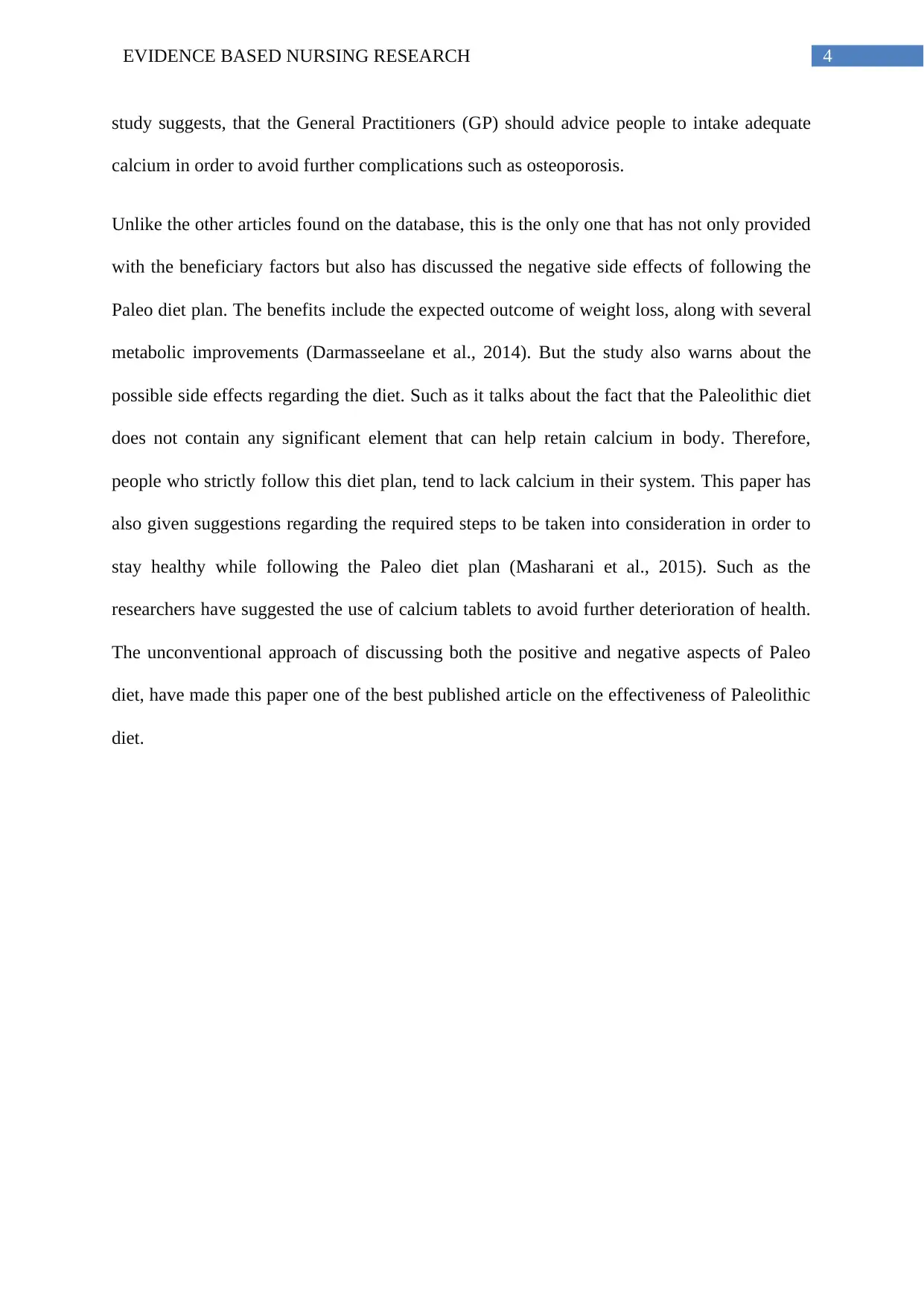
4EVIDENCE BASED NURSING RESEARCH
study suggests, that the General Practitioners (GP) should advice people to intake adequate
calcium in order to avoid further complications such as osteoporosis.
Unlike the other articles found on the database, this is the only one that has not only provided
with the beneficiary factors but also has discussed the negative side effects of following the
Paleo diet plan. The benefits include the expected outcome of weight loss, along with several
metabolic improvements (Darmasseelane et al., 2014). But the study also warns about the
possible side effects regarding the diet. Such as it talks about the fact that the Paleolithic diet
does not contain any significant element that can help retain calcium in body. Therefore,
people who strictly follow this diet plan, tend to lack calcium in their system. This paper has
also given suggestions regarding the required steps to be taken into consideration in order to
stay healthy while following the Paleo diet plan (Masharani et al., 2015). Such as the
researchers have suggested the use of calcium tablets to avoid further deterioration of health.
The unconventional approach of discussing both the positive and negative aspects of Paleo
diet, have made this paper one of the best published article on the effectiveness of Paleolithic
diet.
study suggests, that the General Practitioners (GP) should advice people to intake adequate
calcium in order to avoid further complications such as osteoporosis.
Unlike the other articles found on the database, this is the only one that has not only provided
with the beneficiary factors but also has discussed the negative side effects of following the
Paleo diet plan. The benefits include the expected outcome of weight loss, along with several
metabolic improvements (Darmasseelane et al., 2014). But the study also warns about the
possible side effects regarding the diet. Such as it talks about the fact that the Paleolithic diet
does not contain any significant element that can help retain calcium in body. Therefore,
people who strictly follow this diet plan, tend to lack calcium in their system. This paper has
also given suggestions regarding the required steps to be taken into consideration in order to
stay healthy while following the Paleo diet plan (Masharani et al., 2015). Such as the
researchers have suggested the use of calcium tablets to avoid further deterioration of health.
The unconventional approach of discussing both the positive and negative aspects of Paleo
diet, have made this paper one of the best published article on the effectiveness of Paleolithic
diet.
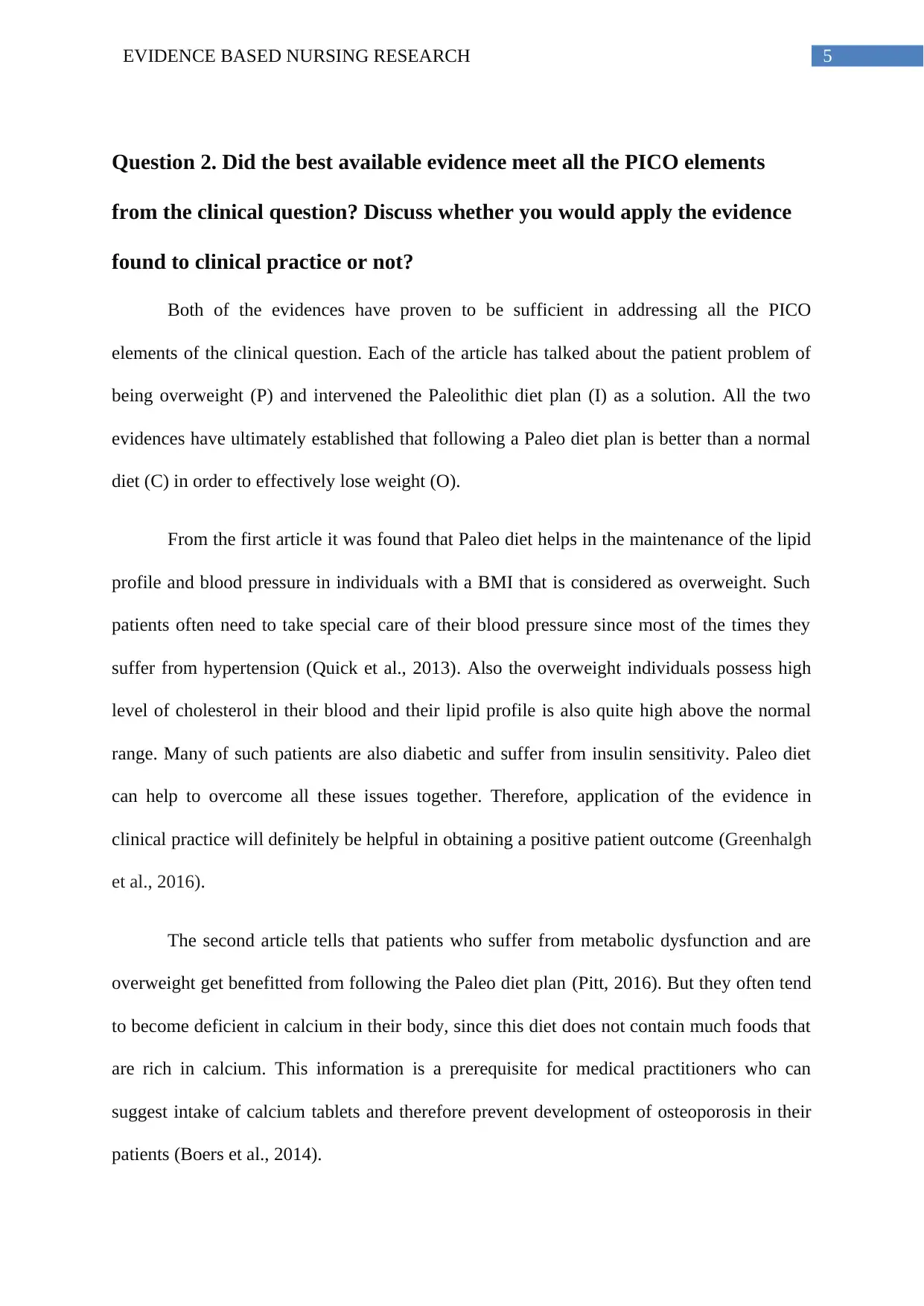
5EVIDENCE BASED NURSING RESEARCH
Question 2. Did the best available evidence meet all the PICO elements
from the clinical question? Discuss whether you would apply the evidence
found to clinical practice or not?
Both of the evidences have proven to be sufficient in addressing all the PICO
elements of the clinical question. Each of the article has talked about the patient problem of
being overweight (P) and intervened the Paleolithic diet plan (I) as a solution. All the two
evidences have ultimately established that following a Paleo diet plan is better than a normal
diet (C) in order to effectively lose weight (O).
From the first article it was found that Paleo diet helps in the maintenance of the lipid
profile and blood pressure in individuals with a BMI that is considered as overweight. Such
patients often need to take special care of their blood pressure since most of the times they
suffer from hypertension (Quick et al., 2013). Also the overweight individuals possess high
level of cholesterol in their blood and their lipid profile is also quite high above the normal
range. Many of such patients are also diabetic and suffer from insulin sensitivity. Paleo diet
can help to overcome all these issues together. Therefore, application of the evidence in
clinical practice will definitely be helpful in obtaining a positive patient outcome (Greenhalgh
et al., 2016).
The second article tells that patients who suffer from metabolic dysfunction and are
overweight get benefitted from following the Paleo diet plan (Pitt, 2016). But they often tend
to become deficient in calcium in their body, since this diet does not contain much foods that
are rich in calcium. This information is a prerequisite for medical practitioners who can
suggest intake of calcium tablets and therefore prevent development of osteoporosis in their
patients (Boers et al., 2014).
Question 2. Did the best available evidence meet all the PICO elements
from the clinical question? Discuss whether you would apply the evidence
found to clinical practice or not?
Both of the evidences have proven to be sufficient in addressing all the PICO
elements of the clinical question. Each of the article has talked about the patient problem of
being overweight (P) and intervened the Paleolithic diet plan (I) as a solution. All the two
evidences have ultimately established that following a Paleo diet plan is better than a normal
diet (C) in order to effectively lose weight (O).
From the first article it was found that Paleo diet helps in the maintenance of the lipid
profile and blood pressure in individuals with a BMI that is considered as overweight. Such
patients often need to take special care of their blood pressure since most of the times they
suffer from hypertension (Quick et al., 2013). Also the overweight individuals possess high
level of cholesterol in their blood and their lipid profile is also quite high above the normal
range. Many of such patients are also diabetic and suffer from insulin sensitivity. Paleo diet
can help to overcome all these issues together. Therefore, application of the evidence in
clinical practice will definitely be helpful in obtaining a positive patient outcome (Greenhalgh
et al., 2016).
The second article tells that patients who suffer from metabolic dysfunction and are
overweight get benefitted from following the Paleo diet plan (Pitt, 2016). But they often tend
to become deficient in calcium in their body, since this diet does not contain much foods that
are rich in calcium. This information is a prerequisite for medical practitioners who can
suggest intake of calcium tablets and therefore prevent development of osteoporosis in their
patients (Boers et al., 2014).
⊘ This is a preview!⊘
Do you want full access?
Subscribe today to unlock all pages.

Trusted by 1+ million students worldwide

6EVIDENCE BASED NURSING RESEARCH
References:
Boers, I., Muskiet, F. A., Berkelaar, E., Schut, E., Penders, R., Hoenderdos, K., ... & Jong, M.
C. (2014). Favourable effects of consuming a Palaeolithic-type diet on characteristics
of the metabolic syndrome: a randomized controlled pilot-study. Lipids in health and
disease, 13(1), 160.
Darmasseelane, K., Hyde, M. J., Santhakumaran, S., Gale, C., & Modi, N. (2014). Mode of
delivery and offspring body mass index, overweight and obesity in adult life: a
systematic review and meta-analysis. PloS one, 9(2), e87896.
Greenhalgh, T., Bidewell, J., Crisp, E., Lambros, A., & Warland, J. (2016). Understanding
Research Methods for Evidence-Based Practice in Health 1e.
Manheimer, E. W., van Zuuren, E. J., Fedorowicz, Z., & Pijl, H. (2015). Paleolithic nutrition
for metabolic syndrome: systematic review and meta-analysis, 2. The American
journal of clinical nutrition, 102(4), 922-932.
Martin, C. A., & Akers, J. (2013). Paleo Diet Versus Modified Paleo Diet: A Randomized
Control Trial of Weight Loss and Biochemical Benefit. Journal of the Academy of
Nutrition and Dietetics, 113(9), A35.
Masharani, U., Sherchan, P., Schloetter, M., Stratford, S., Xiao, A., Sebastian, A., ... &
Frassetto, L. (2015). Metabolic and physiologic effects from consuming a hunter-
gatherer (Paleolithic)-type diet in type 2 diabetes. European journal of clinical
nutrition, 69(8), 944.
References:
Boers, I., Muskiet, F. A., Berkelaar, E., Schut, E., Penders, R., Hoenderdos, K., ... & Jong, M.
C. (2014). Favourable effects of consuming a Palaeolithic-type diet on characteristics
of the metabolic syndrome: a randomized controlled pilot-study. Lipids in health and
disease, 13(1), 160.
Darmasseelane, K., Hyde, M. J., Santhakumaran, S., Gale, C., & Modi, N. (2014). Mode of
delivery and offspring body mass index, overweight and obesity in adult life: a
systematic review and meta-analysis. PloS one, 9(2), e87896.
Greenhalgh, T., Bidewell, J., Crisp, E., Lambros, A., & Warland, J. (2016). Understanding
Research Methods for Evidence-Based Practice in Health 1e.
Manheimer, E. W., van Zuuren, E. J., Fedorowicz, Z., & Pijl, H. (2015). Paleolithic nutrition
for metabolic syndrome: systematic review and meta-analysis, 2. The American
journal of clinical nutrition, 102(4), 922-932.
Martin, C. A., & Akers, J. (2013). Paleo Diet Versus Modified Paleo Diet: A Randomized
Control Trial of Weight Loss and Biochemical Benefit. Journal of the Academy of
Nutrition and Dietetics, 113(9), A35.
Masharani, U., Sherchan, P., Schloetter, M., Stratford, S., Xiao, A., Sebastian, A., ... &
Frassetto, L. (2015). Metabolic and physiologic effects from consuming a hunter-
gatherer (Paleolithic)-type diet in type 2 diabetes. European journal of clinical
nutrition, 69(8), 944.
Paraphrase This Document
Need a fresh take? Get an instant paraphrase of this document with our AI Paraphraser
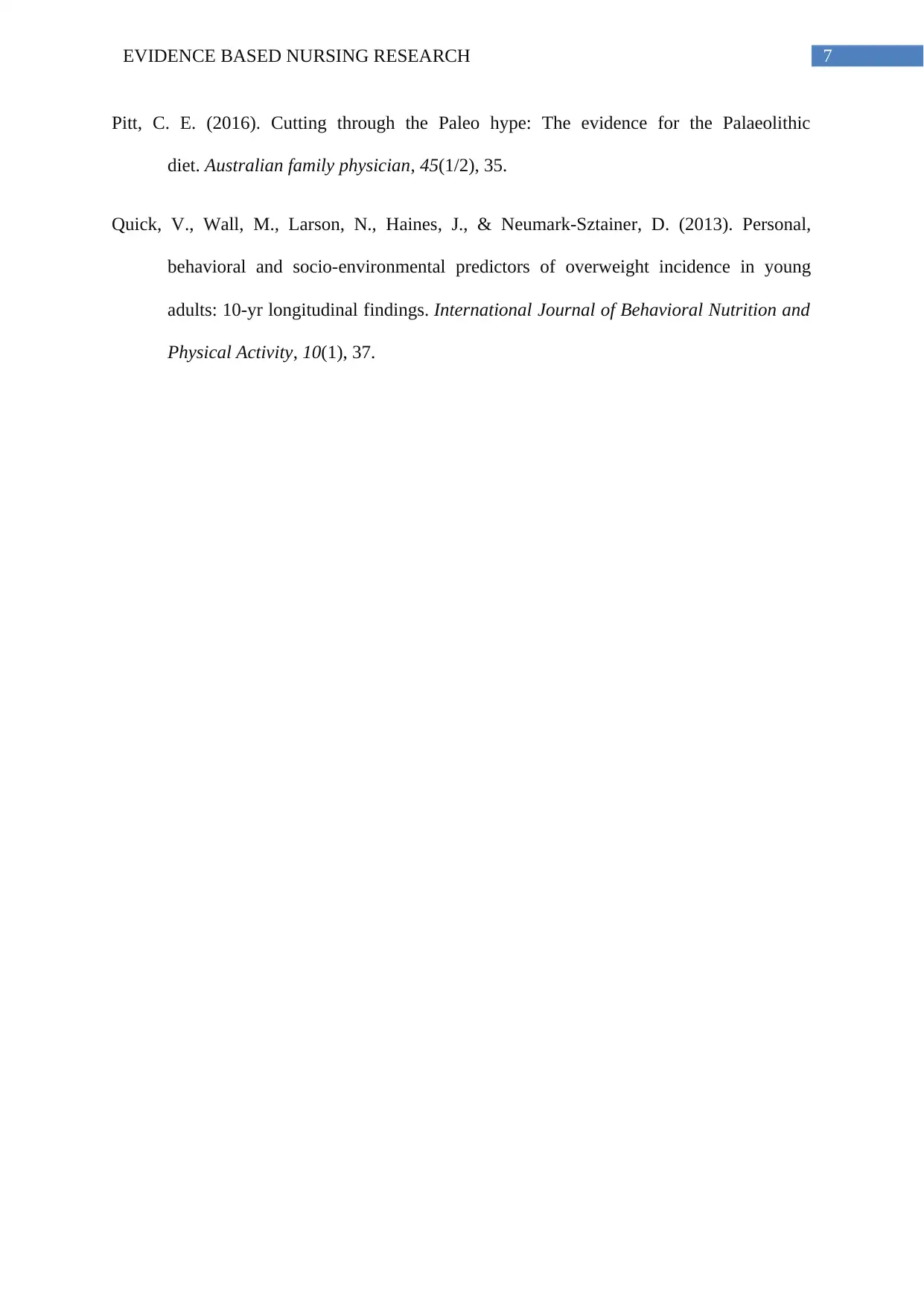
7EVIDENCE BASED NURSING RESEARCH
Pitt, C. E. (2016). Cutting through the Paleo hype: The evidence for the Palaeolithic
diet. Australian family physician, 45(1/2), 35.
Quick, V., Wall, M., Larson, N., Haines, J., & Neumark-Sztainer, D. (2013). Personal,
behavioral and socio-environmental predictors of overweight incidence in young
adults: 10-yr longitudinal findings. International Journal of Behavioral Nutrition and
Physical Activity, 10(1), 37.
Pitt, C. E. (2016). Cutting through the Paleo hype: The evidence for the Palaeolithic
diet. Australian family physician, 45(1/2), 35.
Quick, V., Wall, M., Larson, N., Haines, J., & Neumark-Sztainer, D. (2013). Personal,
behavioral and socio-environmental predictors of overweight incidence in young
adults: 10-yr longitudinal findings. International Journal of Behavioral Nutrition and
Physical Activity, 10(1), 37.
1 out of 8
Related Documents
Your All-in-One AI-Powered Toolkit for Academic Success.
+13062052269
info@desklib.com
Available 24*7 on WhatsApp / Email
![[object Object]](/_next/static/media/star-bottom.7253800d.svg)
Unlock your academic potential
Copyright © 2020–2025 A2Z Services. All Rights Reserved. Developed and managed by ZUCOL.




